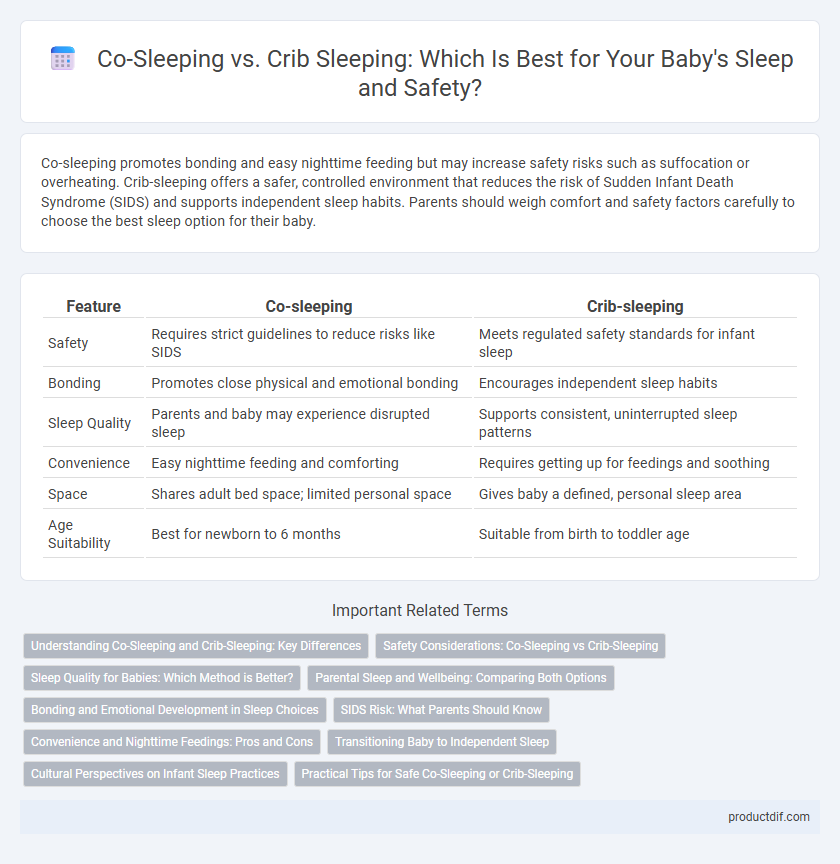Co-sleeping promotes bonding and easy nighttime feeding but may increase safety risks such as suffocation or overheating. Crib-sleeping offers a safer, controlled environment that reduces the risk of Sudden Infant Death Syndrome (SIDS) and supports independent sleep habits. Parents should weigh comfort and safety factors carefully to choose the best sleep option for their baby.
Table of Comparison
| Feature | Co-sleeping | Crib-sleeping |
|---|---|---|
| Safety | Requires strict guidelines to reduce risks like SIDS | Meets regulated safety standards for infant sleep |
| Bonding | Promotes close physical and emotional bonding | Encourages independent sleep habits |
| Sleep Quality | Parents and baby may experience disrupted sleep | Supports consistent, uninterrupted sleep patterns |
| Convenience | Easy nighttime feeding and comforting | Requires getting up for feedings and soothing |
| Space | Shares adult bed space; limited personal space | Gives baby a defined, personal sleep area |
| Age Suitability | Best for newborn to 6 months | Suitable from birth to toddler age |
Understanding Co-Sleeping and Crib-Sleeping: Key Differences
Co-sleeping involves parents and babies sharing the same sleeping surface, promoting close physical contact and potentially fostering bonding and easier nighttime feeding. Crib-sleeping places the baby in a separate, safe sleep environment designed to reduce risks such as SIDS by limiting exposure to adult bedding and suffocation hazards. Understanding these key differences helps parents make informed choices based on safety guidelines, comfort preferences, and family dynamics.
Safety Considerations: Co-Sleeping vs Crib-Sleeping
Co-sleeping poses increased risks such as suffocation, entrapment, and Sudden Infant Death Syndrome (SIDS) due to shared bedding and adult sleep patterns, whereas crib-sleeping with a firm mattress and no loose bedding offers a safer, regulated environment recommended by pediatricians. The American Academy of Pediatrics (AAP) advocates for room-sharing without bed-sharing for the first six months to reduce SIDS risk while maintaining parental proximity. Proper crib safety standards, including adjustable mattress heights and breathable materials, further enhance infant safety compared to co-sleeping setups.
Sleep Quality for Babies: Which Method is Better?
Co-sleeping often promotes more frequent nighttime feeding and quicker parental response, which can improve infant sleep continuity and reduce awakenings. Crib-sleeping encourages independent sleep habits and may reduce the risk of overheating or accidental suffocation, contributing to safer, more stable sleep cycles. Research on sleep quality indicates that both methods have distinct benefits, but factors such as infant age, parental preference, and safety guidelines ultimately influence optimal sleep outcomes for babies.
Parental Sleep and Wellbeing: Comparing Both Options
Co-sleeping can promote parental sleep by facilitating easier nighttime feeding and quicker response to the baby's needs, potentially reducing overall sleep disruptions. Crib-sleeping supports parental wellbeing by encouraging independent sleep habits for the baby, which may lead to longer, uninterrupted rest periods for parents. Research indicates that the choice between co-sleeping and crib-sleeping significantly impacts parental sleep quality and mental health outcomes, emphasizing the need for personalized sleep arrangements.
Bonding and Emotional Development in Sleep Choices
Co-sleeping promotes immediate physical closeness, enhancing bonding and emotional security between baby and parent, which can foster attachment and reduce infant stress. Crib-sleeping supports independent sleep patterns, encouraging self-soothing skills that contribute to emotional regulation and confidence in infants. Both sleep choices impact bonding and emotional development differently, with co-sleeping facilitating intimacy and crib-sleeping promoting autonomy.
SIDS Risk: What Parents Should Know
Co-sleeping increases the risk of sudden infant death syndrome (SIDS) due to factors like accidental suffocation, overheating, and entrapment, especially in unsafe sleep environments or when parents smoke or consume alcohol. Crib-sleeping on a firm mattress, free from loose bedding and soft toys, is recommended by pediatric experts as the safest practice to reduce SIDS risk. Parents should follow guidelines from organizations such as the American Academy of Pediatrics (AAP) to create a safe sleep environment for infants.
Convenience and Nighttime Feedings: Pros and Cons
Co-sleeping offers immediate access for nighttime feedings, reducing the need for parents to fully wake or leave the bed, enhancing convenience especially for breastfeeding mothers. Crib-sleeping promotes independent sleep habits but may require parents to consistently get up for feedings, potentially disrupting rest. Each option balances convenience with sleep quality, where co-sleeping simplifies feeding logistics while crib-sleeping supports structured routines.
Transitioning Baby to Independent Sleep
Transitioning a baby from co-sleeping to crib-sleeping involves establishing consistent bedtime routines and creating a soothing sleep environment to promote independent sleep habits. Parents often introduce familiar objects like a favorite blanket or soft toy in the crib to provide comfort and safety cues. Monitoring sleep patterns and gradually increasing the time spent in the crib can ease the adjustment while reducing nighttime awakenings.
Cultural Perspectives on Infant Sleep Practices
Cultural perspectives significantly shape infant sleep practices, with co-sleeping prevailing in many Asian, African, and Latin American societies as a tradition promoting bonding and breastfeeding convenience. In contrast, Western cultures typically favor crib-sleeping for promoting independent sleep habits and reducing risks associated with sudden infant death syndrome (SIDS). These differing practices reflect deep-rooted beliefs about child-rearing, safety guidelines, and familial closeness, influencing product design and parental choices globally.
Practical Tips for Safe Co-Sleeping or Crib-Sleeping
Safe co-sleeping requires a firm mattress, absence of pillows or heavy blankets, and positioning the baby on their back to reduce SIDS risk. For crib-sleeping, use a certified crib with a tight-fitting sheet, keep the crib free of toys or loose bedding, and maintain a comfortable room temperature between 68-72degF. Both sleep options benefit from consistent routines and close monitoring to ensure infant safety throughout the night.
Co-sleeping vs Crib-sleeping Infographic

 productdif.com
productdif.com